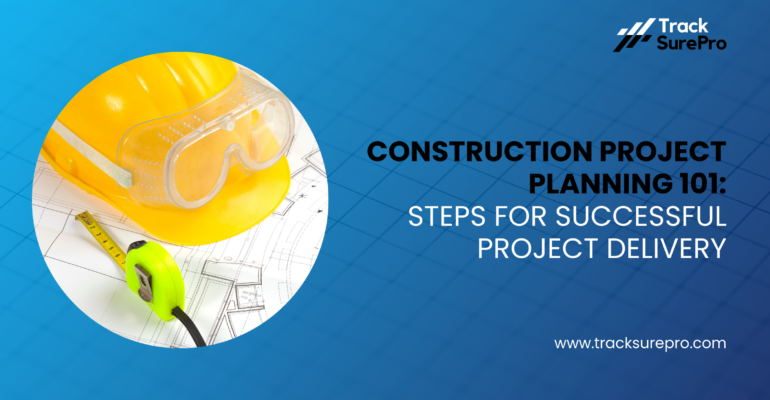Construction Project Planning 101: Steps for Successful Project Delivery

Construction Project Planning 101: Steps for Successful Project Delivery
Introduction:
Construction project planning is the cornerstone of successful project delivery, laying the foundation for timely completion, cost-effectiveness, and quality outcomes. In this comprehensive guide, we’ll delve into the essential steps involved in construction project planning, highlighting the importance of each stage and exploring how leveraging tools like TrackSurePro can enhance planning processes to ensure project success.
Importance of Construction Project Planning:
Effective project planning is crucial for achieving project objectives, managing resources efficiently, and mitigating risks throughout the construction lifecycle. Proper planning enables construction teams to define project scope, set realistic timelines and budgets, allocate resources effectively, and establish clear communication channels among stakeholders. By proactively addressing potential challenges and uncertainties, construction project planning minimizes disruptions, enhances productivity, and ultimately leads to successful project delivery.
Key Steps in Construction Project Planning:
- Define Project Objectives: The first step in project planning is to clearly define project objectives, including scope, budget, timeline, and quality standards. This stage involves conducting thorough feasibility studies, analyzing project requirements, and aligning stakeholders’ expectations to establish project goals and deliverables.
- Develop Project Scope: Once project objectives are defined, construction teams must develop a comprehensive project scope that outlines the work to be completed, deliverables, and key milestones. This stage involves defining project boundaries, identifying required resources, and establishing project constraints and assumptions to ensure clarity and alignment among stakeholders.
- Create Work Breakdown Structure (WBS): Breaking down the project scope into manageable tasks and subtasks is essential for effective project planning. Construction teams utilize work breakdown structure (WBS) techniques to organize project activities hierarchically, allowing for better resource allocation, scheduling, and monitoring throughout the project lifecycle.
- Establish Project Schedule: Developing a realistic project schedule is critical for ensuring timely project completion and resource optimization. Construction project managers use scheduling tools and techniques to sequence project activities, allocate resources, and identify critical path activities to minimize project duration and optimize resource utilization.
- Allocate Resources: Proper resource allocation is essential for meeting project requirements and objectives. Construction project planners identify the necessary labor, materials, equipment, and subcontractors needed to execute project tasks effectively. By aligning resource availability with project demands, construction teams can optimize resource utilization and minimize project delays.
- Develop Risk Management Plan: Construction projects are inherently prone to risks and uncertainties that can impact project success. As part of project planning, construction teams develop a comprehensive risk management plan that identifies potential risks, assesses their likelihood and impact, and outlines strategies for mitigating, transferring, or accepting risks to minimize their impact on project outcomes.
- Establish Communication Protocols: Effective communication is key to project success, ensuring that stakeholders are informed, aligned, and engaged throughout the project lifecycle. Construction project planners establish clear communication protocols, defining roles and responsibilities, communication channels, and reporting mechanisms to facilitate seamless collaboration and decision-making among project stakeholders.
- Implement Tracking and Monitoring Mechanisms: Continuous tracking and monitoring of project progress are essential for identifying deviations from the plan and implementing timely corrective actions. Construction teams leverage project management software like TrackSurePro to track key performance indicators, monitor project milestones, and generate real-time reports to stakeholders, enabling proactive management of project risks and issues.
Critical Analysis:
Construction project planning requires careful consideration of project objectives, scope, resources, risks, and communication protocols to ensure successful project delivery. By following the key steps outlined in this guide and leveraging technology solutions like TrackSurePro, construction teams can enhance their planning processes, minimize project risks, and achieve project success.
TrackSurePro as a Solution:
TrackSurePro offers a comprehensive suite of project management tools specifically designed to streamline construction project planning processes. From defining project objectives to tracking project progress and managing resources, TrackSurePro empowers construction teams to plan, execute, and deliver projects with confidence. With features such as Gantt charts, resource allocation tools, risk management modules, and communication portals, TrackSurePro enhances collaboration, improves visibility, and optimizes project outcomes.
Conclusion:
Construction project planning is a fundamental aspect of project management, laying the groundwork for successful project delivery. By following the essential steps outlined in this guide and utilizing tools like TrackSurePro, construction teams can effectively plan, execute, and deliver projects on time, within budget, and to the highest quality standards. With proper planning and the right technology solutions, construction firms can overcome challenges, mitigate risks, and achieve their project objectives, ultimately driving success in the construction industry.

